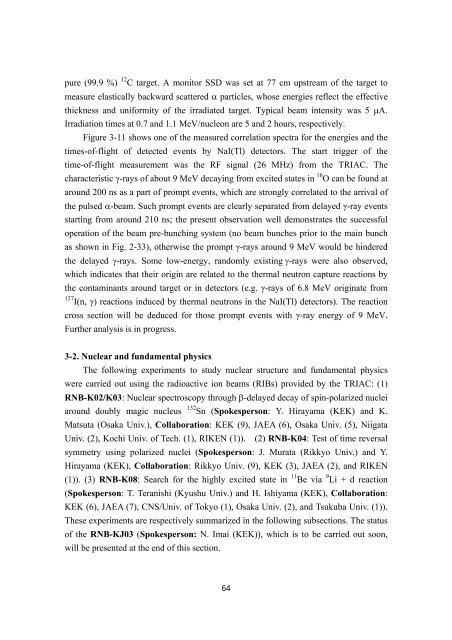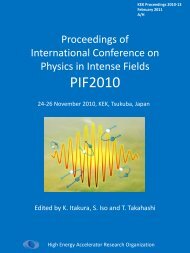TRIAC Progress Report - KEK
TRIAC Progress Report - KEK
TRIAC Progress Report - KEK
Create successful ePaper yourself
Turn your PDF publications into a flip-book with our unique Google optimized e-Paper software.
pure (99.9 %) 12 C target. A monitor SSD was set at 77 cm upstream of the target to<br />
measure elastically backward scattered α particles, whose energies reflect the effective<br />
thickness and uniformity of the irradiated target. Typical beam intensity was 5 µA.<br />
Irradiation times at 0.7 and 1.1 MeV/nucleon are 5 and 2 hours, respectively.<br />
Figure 3-11 shows one of the measured correlation spectra for the energies and the<br />
times-of-flight of detected events by NaI(Tl) detectors. The start trigger of the<br />
time-of-flight measurement was the RF signal (26 MHz) from the <strong>TRIAC</strong>. The<br />
characteristic γ-rays of about 9 MeV decaying from excited states in 16 O can be found at<br />
around 200 ns as a part of prompt events, which are strongly correlated to the arrival of<br />
the pulsed α-beam. Such prompt events are clearly separated from delayed γ-ray events<br />
starting from around 210 ns; the present observation well demonstrates the successful<br />
operation of the beam pre-bunching system (no beam bunches prior to the main bunch<br />
as shown in Fig. 2-33), otherwise the prompt γ-rays around 9 MeV would be hindered<br />
the delayed γ-rays. Some low-energy, randomly existing γ-rays were also observed,<br />
which indicates that their origin are related to the thermal neutron capture reactions by<br />
the contaminants around target or in detectors (e.g. γ-rays of 6.8 MeV originate from<br />
127<br />
I(n, γ) reactions induced by thermal neutrons in the NaI(Tl) detectors). The reaction<br />
cross section will be deduced for those prompt events with γ-ray energy of 9 MeV.<br />
Further analysis is in progress.<br />
3-2. Nuclear and fundamental physics<br />
The following experiments to study nuclear structure and fundamental physics<br />
were carried out using the radioactive ion beams (RIBs) provided by the <strong>TRIAC</strong>: (1)<br />
RNB-K02/K03: Nuclear spectroscopy through β-delayed decay of spin-polarized nuclei<br />
around doubly magic nucleus 132 Sn (Spokesperson: Y. Hirayama (<strong>KEK</strong>) and K.<br />
Matsuta (Osaka Univ.), Collaboration: <strong>KEK</strong> (9), JAEA (6), Osaka Univ. (5), Niigata<br />
Univ. (2), Kochi Univ. of Tech. (1), RIKEN (1)). (2) RNB-K04: Test of time reversal<br />
symmetry using polarized nuclei (Spokesperson: J. Murata (Rikkyo Univ.) and Y.<br />
Hirayama (<strong>KEK</strong>), Collaboration: Rikkyo Univ. (9), <strong>KEK</strong> (3), JAEA (2), and RIKEN<br />
(1)). (3) RNB-K08: Search for the highly excited state in 11 Be via 9 Li + d reaction<br />
(Spokesperson: T. Teranishi (Kyushu Univ.) and H. Ishiyama (<strong>KEK</strong>), Collaboration:<br />
<strong>KEK</strong> (6), JAEA (7), CNS/Univ. of Tokyo (1), Osaka Univ. (2), and Tsukuba Univ. (1)).<br />
These experiments are respectively summarized in the following subsections. The status<br />
of the RNB-KJ03 (Spokesperson: N. Imai (<strong>KEK</strong>)), which is to be carried out soon,<br />
will be presented at the end of this section.<br />
64













